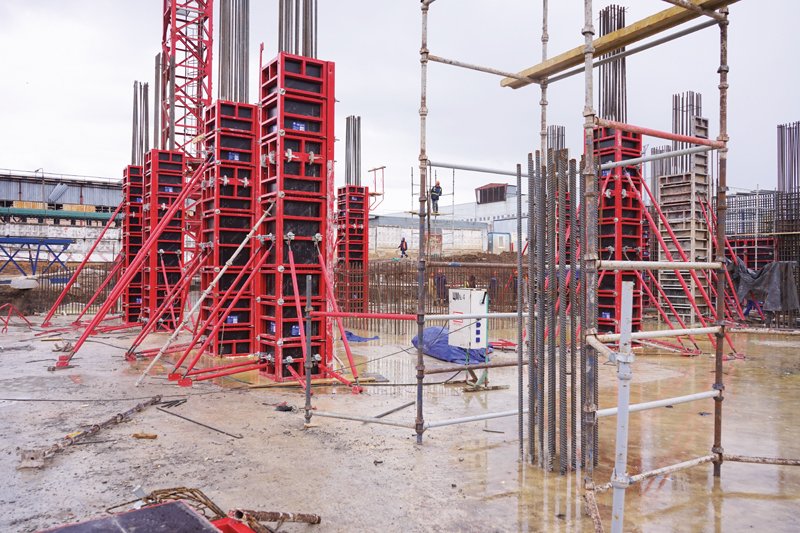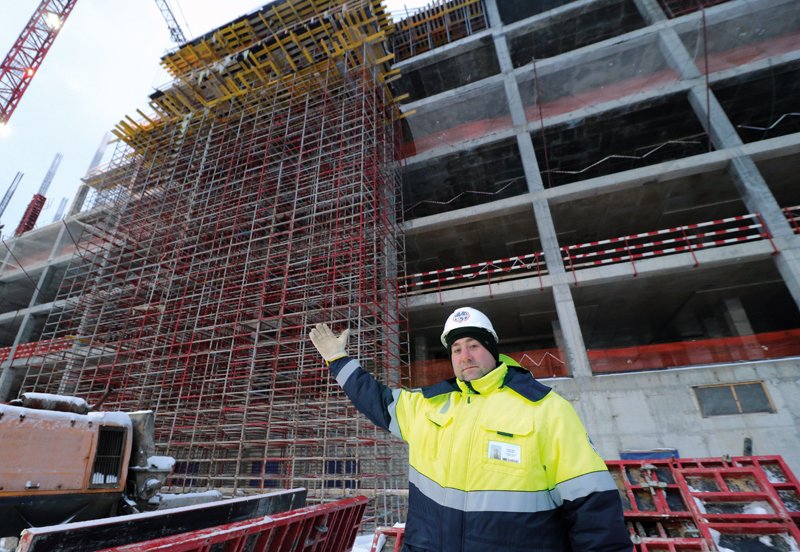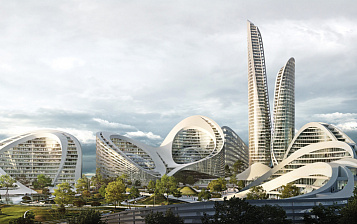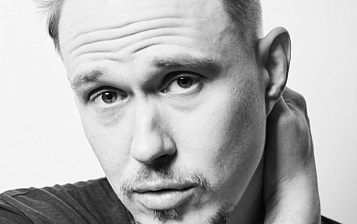Two years ago, in February 2019, President Putin, in his address to the Federal Assembly, announced the construction of a new central office of the state corporation ROSCOSMOS as one of the priorities for the capital. The expenses were assumed by the Moscow government, which decided to invest 26 billion in a comprehensive transformation of the territory of the plant. Khrunichev in Fili. This island of late Soviet industrial disorder between Kutuzovsky Prospekt and MIBC has long been of interest to developers and, perhaps, will become the meaning and heart of the long-cherished "Big City". At least that's what the Moscow mayor's office wants. What happened in 2 turbulent years and is there a chance for opening by 2023, as planned by the president, studied at the construction site special. Maxim Kirsanov, Gorproekt magazine correspondent.
How to keep the pace of construction in difficult times
The Unified Housing Construction Information System (UIIS) of the state company Dom.RF reports that, in general, by the beginning of 2021, construction volumes in the country still have not returned to pre-epidemic levels. In January last year, about 9,800 houses (or 102.8 million sq. m.) were built, this January only 8,400 houses, or 92 million sq. m. Against the backdrop of housing construction, other subcategories of the industry are entering in good condition by the beginning of 2021: even retail construction has begun to return in the form of small regional shopping centers (in Moscow alone, it is planned to open almost 1 million square meters of rentable space during the year), and the locomotive of the industry was, of course, administrative and infrastructure construction, which increased the pace throughout the year, despite any troubles in the country and the world.

Even in January 2021, when unprecedented temperature anomalies hit the European part of Russia, builders who were already accustomed to the conditions of the state of emergency did not slow down their work. Once at the construction site of the NCC in the middle of the plant. Khrunichev, you immediately understand that the ROSCOSMOS facility is among the leaders: almost 800 workers on the site, around the clock erecting huge monolithic structures comparable to nuclear power plant buildings, make an impression. Just a few months ago, at an object occupying 7 hectares and more than 250 thousand square meters. meters completed the construction of the foundation and underground parking, and now the height of the future giant is approaching the level of the 7th floor. There will be 47 of them in total in the highest corner part of the complex, where a 260-meter tower with a space communications tower (after all, even a new Mission Control Center (MCC) is planned in it - an additional situational center to the already existing one in Korolev) will become the new dominant of the area. “That is, about 85% is left?”, we ask Ivan Sergeevich, head of the Section, Sergeev, from MIP-Stroy No. 1, who agreed to give an interview for Gorproekt at the construction site. He does not agree, since the most complex has already been done in the fall and this winter with the help of PSK-CUP volumetric formwork systems: we are talking about the first floors of the complex, which will combine production, office, exhibition, educational and other functions. “The fact is that we are the National Space Center - this is an unusual skyscraper,” the specialist describes, showing huge meter-long protruding ceilings of the facade and very high ceilings of the first floors (up to 28 meters!), More like the atriums of a mall or factories. “This skyscraper is not so much for office workers, but for engineers, and also for sometimes very massive equipment.”

Why the ROSCOSMOS skyscraper is special
We are used to office and residential skyscrapers. In 2020, the builders of D1 and Capital Towers took the Moscow sky by storm, in 2019 - Nebo LCD in the South of Moscow and NEVA Towers in the City. In total, there are already almost a hundred such high-rise objects, only in the portfolio of PromStroyKontrakt Group of Companies. However, can skyscrapers be used in another way? Like huge clusters that unite laboratories, workshops, production facilities and even conveyors? This question can baffle even the historian of architecture. This idea was developed by the constructivists of the USSR in the 1920s, partly it was embodied by the skyscraper of the Daily News newspaper in New York, and even more so by the skyscraper of Moscow University. Nowadays, similar ideas are being promoted by some Asian corporations, such as China's Tencent, whose high-rise headquarters also contains laboratories and manufacturing facilities. However, what is the assembly of microelectronics against the background of satellites and rocket elements? The decision to insert industrial production facilities into the annexes of a skyscraper, even if it is such a piece and individually designed product as elements of space systems, is really unusual. Of course, engineers and their laboratories will not be in the high-rise part (it would simply be unsafe, it's good that Roscosmos has its own production of high-speed elevators). The complex will contain many production blocks - "keys" adjacent to the common elongated axis of the building under construction. In a sense, the ROSATOM skyscraper will become both “vertical” and “horizontal” at the same time (that is, the length of both parts will be proportional), which, due to the sloping “triangular” roof, will add resemblance to the logo of the state corporation.

Why such difficulties? On the one hand, the explanation lies on the surface: the work of the plant. Khrunichev should not be suspended, and its modernization is taking place on a former wasteland, behind which the construction of new high-tech blocks as part of a future skyscraper. The famous journalist and Roscosmos employee Ivan Safronov, in his investigation on this topic (“I am the earth, I see off my hectares” in Kommersant No. optimization. The Moscow City Hall, which pays for the construction of a skyscraper and infrastructure, including four bridges, in return receives tidbits in the center and sites for the "renovation" of the Fili district in the immediate vicinity of the plant. Khrunichev.
On the other hand, bringing together the administrative offices and engineering departments is designed to solve an important problem of all space centers: the difficulty of “matching” scientific interests (which engineers defend) and the fulfillment of a specific state order, for which the company administration is responsible. Back in the 1980s, after the explosion of the Challenger shuttle, President Reagan's commission found out that this was precisely the problem that was typical for NASA. So sometimes contradictions between officials and scientists, the lack of operational interaction in the heat of disputes about ever-burning deadlines, can lead to real disasters. But also for the sustainable development of the company, it is important to improve communication between departments. We talked about this in an article about the construction of the Sberbank Technopark in SKOLKOVO.
It is characteristic that, in order to solve a similar problem, ROSCOSMOS chose the UNK project at an open competition, which had experience working on high-rise objects (Empire Tower in the City) and on educational clusters (in Skolkovo and Irkutsk) and on the headquarters of large corporations (for example, MAIL.ru) and even over another image project of the Russian state industry: the VDNKh pavilion of ROSATOM, which, like the National Space Center, is designed to promote Russian technologies around the world. At the same time, the brainchild of Sergei Kiriyenko, by its very nature (as ultimately the “sellers” of electricity) is in a more favorable financial position than the organization managed by Dmitry Rogozin, which, on the one hand, solves political problems (and the construction of the new Vostochny Cosmodrome ” instead of Baikonur - only one of them), and at the same time, as it should be for real scientists, he strives to spend more than earn, at least for now. But we do know that space, where our country was the first, in the bright future, glorified by science fiction writers, will still return all investments to us a hundredfold.
In the meantime, the new structure of ROSATOM, optimized by modern architecture, after moving to the NCC, will quite possibly allow us to eventually keep up with neither Elon Musk and his Space X, nor other competitors. In 2020, 114 space launches took place all over the Earth, of which only 17 were Russian. However, that year was not in vain one of the most difficult in the history of mankind. It is quite possible that after the anti-record we will find the bottom and again rush to the cosmic heights.
Information partner psk-holding.ru


 DOWNLOAD
DOWNLOAD LOOK
LOOK Top Content of the Month
Top Content of the Month


